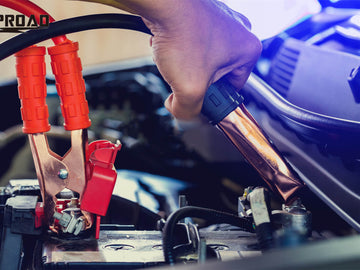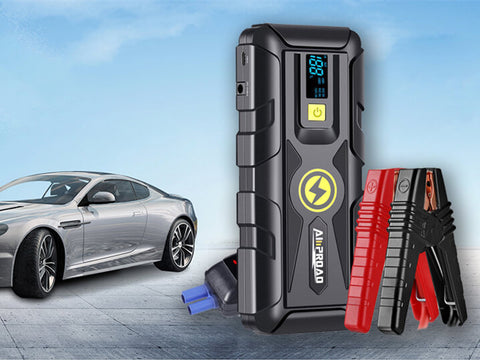
A jump start can get a vehicle running again, but what happens to the battery afterward isn't always clear. While the process itself doesn’t necessarily mean a replacement is needed, factors like battery age, overall condition, and the reason for the initial failure determine its long-term reliability. Repeated jump-starts may indicate a deeper issue, such as a failing battery or charging system problem. Understanding these factors can help in assessing whether a simple recharge is enough or if a new battery is the better option to keep the vehicle running smoothly.
Do You Need to Replace Battery after Jump Start?
Replacing a battery after a jump start isn’t always necessary, but several factors determine its long-term viability. The condition of the battery before the jump start plays a key role—if it was already weak or nearing the end of its lifespan, a replacement may be inevitable. Additionally, the quality and compatibility of the jump starter used can impact battery health. A car battery booster that delivers excessive voltage or is incompatible with the vehicle’s electrical system may cause further damage.
Repeated jump starts without addressing the root cause of the battery drain can also accelerate wear, reducing its ability to hold a charge. If the battery remains discharged for too long before being jump-started, sulfation may occur, making recovery less likely. Environmental factors, such as extreme temperatures or frequent short trips, can further hinder recharging and affect overall battery performance. To ensure reliability, testing the battery’s charge-holding capacity and monitoring for recurring issues can help determine if a replacement is the best course of action.
Does Jump Starting Affect Battery Longevity?
Jump-starting a vehicle can indeed impact the longevity of its battery, although the extent of the impact varies based on several factors. When a car battery is jump-started, it undergoes a rapid discharge of power to provide the necessary boost to start the engine. This sudden discharge can strain the battery, potentially affecting its overall health and lifespan.
Repeated jump-starts can further exacerbate this strain, leading to accelerated wear and tear on the battery. Additionally, if the underlying cause of the initial battery drain is not addressed, such as a malfunctioning alternator or parasitic draw, it can contribute to ongoing battery issues and reduce its lifespan even further.
However, it's important to note that occasional jump-starts under normal circumstances may not significantly impact battery longevity, especially if the battery is relatively new and well-maintained. Regular maintenance, such as checking battery terminals for corrosion, ensuring proper charging, and addressing any electrical issues promptly, can help mitigate the effects of jump-starting on battery health. Ultimately, while jump-starting can have an impact on battery longevity, proactive maintenance and addressing underlying issues can help minimize this impact and ensure reliable performance from your vehicle's battery over time.

Are There Signs for Battery Replacement Post-Jump Start?
Following a jump start, certain signs may indicate the need for battery replacement. One common indication is if the vehicle continues to experience difficulty starting even after being jump-started. If the battery is unable to hold a charge or is failing to recharge properly, it may be a sign of internal damage or deterioration, necessitating replacement. Additionally, if the vehicle's electrical systems exhibit unusual behavior, such as dimming headlights, flickering dashboard lights, or malfunctioning accessories, it could indicate battery issues post-jump start.
Another sign that may signal the need for battery replacement is if the vehicle experiences frequent or recurrent battery drain issues. If the battery repeatedly loses its charge, even after jump-starting and driving the vehicle, it may indicate underlying battery issues that require attention. In such cases, it's essential to assess whether the battery is retaining its charge adequately and if the alternator and charging system are functioning correctly.
Furthermore, if the battery displays visible signs of damage, such as corrosion on the terminals, bulging or leaking, it is likely compromised and should be replaced promptly. These physical indicators suggest internal damage or electrolyte leakage, both of which can affect battery performance and longevity. Regular visual inspections of the battery and its components can help identify potential issues early on and prevent further damage.
Lastly, if the vehicle's battery is several years old or has exceeded its expected lifespan, it may be prudent to consider replacement, especially if it has undergone multiple jump-starts or shows signs of deterioration. While jump-starting can provide a temporary solution, it may not address underlying battery issues or prevent future failures. Therefore, if the battery is nearing the end of its service life, replacing it proactively can help avoid unexpected breakdowns and ensure reliable performance.
How to Extend Battery Lifespan After a Jump Start?
Extending the lifespan of your car battery after a jump start involves several essential steps to ensure its health and longevity. First and foremost, it's crucial to understand how to boost a car properly to minimize stress on the battery and electrical system. When jump-starting a vehicle, it's essential to follow the correct procedure, including connecting the jumper cables in the correct order and allowing the donor vehicle to run for a few minutes to charge the dead battery gradually.
Once the vehicle has been successfully jump-started, it's advisable to take preventive measures to maintain the battery's health. Regularly driving the vehicle for extended periods can help recharge the battery fully and prevent it from becoming depleted again. Additionally, avoiding frequent short trips and minimizing the use of electrical accessories when the engine is not running can help preserve battery life.
Proper battery maintenance is also crucial for extending its lifespan after a jump start. This includes keeping the battery terminals clean and free of corrosion, as buildup can impede electrical conductivity and lead to voltage drop issues. Periodically inspecting the battery for signs of damage or deterioration, such as bulging, leaking, or excessive wear, can help identify potential problems early on and prevent further damage.
Furthermore, investing in a battery tender or maintainer can help keep the battery charged and maintained during periods of inactivity, such as during storage or when the vehicle is not in use for extended periods. These devices provide a low-level trickle charge to the battery, preventing it from becoming discharged and helping to preserve its capacity over time.
Lastly, consulting the vehicle's owner's manual for specific recommendations and guidelines regarding battery maintenance and care is essential. Following manufacturer-recommended procedures for jump-starting, charging, and maintaining the battery can help ensure optimal performance and longevity. By implementing these practices consistently, you can extend the lifespan of your car battery after a jump start with a car jump box or other tool and enjoy reliable starting power for years to come.

Should You Consult Professionals About Battery Condition?
Consulting professionals about the condition of your car battery can be beneficial, especially if you're uncertain about its health or experiencing recurring issues. Auto technicians and mechanics possess the expertise and diagnostic tools necessary to assess the battery's condition accurately. They can conduct a thorough inspection, checking the battery's voltage, load capacity, and overall performance to determine if it's functioning optimally.
Professionals can also identify underlying issues that may be contributing to battery problems, such as faulty charging systems, electrical malfunctions, or parasitic drains. By diagnosing and addressing these issues promptly, they can prevent further damage to the battery and other vehicle components, ultimately saving you time and money in the long run.
Additionally, consulting professionals can provide valuable recommendations for battery maintenance and replacement if necessary. They can advise you on proper charging procedures, preventive measures to extend battery life, and suitable replacement options based on your vehicle's specifications and driving habits. Leveraging high-quality jump starters from manufacturers like Amproad can also complement professional advice, ensuring you're equipped with reliable tools for jump-starting your vehicle whenever needed. Ultimately, seeking professional assistance can provide peace of mind and ensure that your car battery remains in optimal condition, minimizing the risk of unexpected breakdowns and inconvenience on the road.


